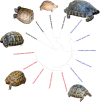Niche diversification of Mediterranean and southwestern Asian tortoises
- PMID: 35846890
- PMCID: PMC9281595
- DOI: 10.7717/peerj.13702
Niche diversification of Mediterranean and southwestern Asian tortoises
Abstract
Background: Tortoises of the genus Testudo are widely distributed throughout the Mediterranean region and southwestern Asia. However, the evolutionary mechanisms of diversification in this genus are still poorly understood.
Methods: In this study, we assessed the evolutionary patterns in the climate niches of five species and 11 subspecies of the genus Testudo using ecological niche models and evaluated the niche overlap based on species phylogenetic distances.
Results: The ecological models indicated that most species differ in their climate niches, but show overlap, with gradual transitions at range boundaries. As expected, the ecological divergence among subspecies was lower than that among species. Evaluation of the phylogenetic signal indicated that climate niches have been weakly conserved, but sister species also show high evolutionary divergence.
Keywords: Ecology; Evolution; Glacial cycles; Refugia; Reptiles; Testudo.
©2022 Escoriza and Ben Hassine.
Conflict of interest statement
The authors declare there are no competing interests.
Figures





Similar articles
-
Climatic niche evolution in turtles is characterized by phylogenetic conservatism for both aquatic and terrestrial species.J Evol Biol. 2019 Jan;32(1):66-75. doi: 10.1111/jeb.13395. Epub 2018 Nov 27. J Evol Biol. 2019. PMID: 30387214
-
The phylogeny of Mediterranean tortoises and their close relatives based on complete mitochondrial genome sequences from museum specimens.Mol Phylogenet Evol. 2006 Jan;38(1):50-64. doi: 10.1016/j.ympev.2005.07.015. Epub 2005 Sep 16. Mol Phylogenet Evol. 2006. PMID: 16150614
-
Widespread correlations between climatic niche evolution and species diversification in birds.J Anim Ecol. 2016 Jul;85(4):869-78. doi: 10.1111/1365-2656.12530. Epub 2016 May 12. J Anim Ecol. 2016. PMID: 27064436
-
Ancient diversification, biogeography, and the role of climatic niche evolution in the Old World cat snakes (Colubridae, Telescopus).Mol Phylogenet Evol. 2019 May;134:35-49. doi: 10.1016/j.ympev.2019.01.015. Epub 2019 Jan 29. Mol Phylogenet Evol. 2019. PMID: 30703516
-
Environmental niche variation and evolutionary diversification of the Brachypodium distachyon grass complex species in their native circum-Mediterranean range.Am J Bot. 2015 Jul;102(7):1073-88. doi: 10.3732/ajb.1500128. Epub 2015 Jul 16. Am J Bot. 2015. PMID: 26199365
Cited by
-
Taking advantage of reference-guided assembly in a slowly-evolving lineage: Application to Testudo graeca.PLoS One. 2024 Aug 9;19(8):e0303408. doi: 10.1371/journal.pone.0303408. eCollection 2024. PLoS One. 2024. PMID: 39121089 Free PMC article.
-
Mitochondrial DNA and Distribution Modelling Evidenced the Lost Genetic Diversity and Wild-Residence of Star Tortoise, Geochelone elegans (Testudines: Testudinidae) in India.Animals (Basel). 2022 Dec 30;13(1):150. doi: 10.3390/ani13010150. Animals (Basel). 2022. PMID: 36611759 Free PMC article.
References
-
- Acevedo P, Jiménez-Valverde A, Lobo JM, Real R. Delimiting the geographical background in species distribution modelling. Journal of Biogeography. 2012;39:1383–1390. doi: 10.1111/j.1365-2699.2012.02713.x. - DOI
-
- Aiello-Lammens ME, Boria RA, Radosavljevic A, Vilela B, Anderson RP. spThin: an R package for spatial thinning of species occurrence records for use in ecological niche models. Ecography. 2015;38:541–545. doi: 10.1111/ecog.01132. - DOI
-
- Anadón JD, Giménez A, Graciá E, Pérez I, Ferrández M, Fahd S, El Mouden H, Kalboussi M, Jdeidi T, Larbes S, Rouag R. Distribution of Testudo graeca in the western Mediterranean according to climatic factors. Amphibia-Reptilia. 2012;33:285–296. doi: 10.1163/156853812X643710. - DOI
-
- Anadón JD, Giménez A, Martínez M, Martínez J, Pérez I, Esteve MA. Factors determining the distribution of the spur-thighed tortoise Testudo graeca in south-east Spain: a hierarchical approach. Ecography. 2006;29:339–346. doi: 10.1111/j.2006.0906-7590.04486.x. - DOI
-
- Anadón JD, Graciá E, Botella F, Giménez A, Fahd S, Fritz U. Individualistic response to past climate changes: niche differentiation promotes diverging Quaternary range dynamics in the subspecies of Testudo graeca. Ecography. 2015;38:956–966. doi: 10.1111/ecog.01163. - DOI
MeSH terms
LinkOut - more resources
Full Text Sources
Research Materials

